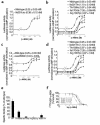Melanocortin-4 receptor mutations are a frequent and heterogeneous cause of morbid obesity
- PMID: 10903341
- PMCID: PMC314306
- DOI: 10.1172/JCI9238
Melanocortin-4 receptor mutations are a frequent and heterogeneous cause of morbid obesity
Abstract
By integrating an agonist satiety signal, provided by alpha-melanocyte-stimulating hormone (alpha-MSH), and an antagonist signal, provided by agouti-related protein (AGRP), the melanocortin-4 receptor (MC4-R) is a key element in the hypothalamic control of food intake. Inactivation of the gene encoding this G protein-coupled receptor causes obesity in mice. In humans, frameshift mutations in MC4-R cause an early-onset dominant form of obesity in two families. In this study we find a high frequency (4%) of rare heterozygous MC4-R mutations in a large population of morbidly obese patients. No such mutations were found in controls. By analyzing the phenotypes of the probands carrying these mutations, we demonstrate that these patients display a common, nonsyndromic form of obesity. Interestingly, functional analysis of the mutant receptors indicates that obesity-associated defects in MC4-R range from loss of function to constitutive activation. Transmission of these mutations in the families of the carriers indicates a variable expressivity that is not related to the functional severity of the mutations. This variable expressivity of MC4-R-associated obesity is not due to variations in genes for alpha-MSH or AGRP. Taken together, these results demonstrate that MC4-R mutations are a frequent but heterogeneous genetic cause of morbid obesity.
Figures


Comment in
-
Haploinsufficiency of the melanocortin-4 receptor: part of a thrifty genotype?J Clin Invest. 2000 Jul;106(2):185-7. doi: 10.1172/JCI10628. J Clin Invest. 2000. PMID: 10903333 Free PMC article. No abstract available.
References
-
- Allison DB, Fontaine KR, Manson JE, Stevens J, VanItallie TB. Annual deaths attributable to obesity in the United States. JAMA. 1999;282:1530–1538. - PubMed
-
- Must A, et al. The disease burden associated with overweight and obesity. JAMA. 1999;282:1523–1529. - PubMed
-
- 1998. Obesity: preventing and managing the global epidemic. World Health Organization. Geneva, Switzerland. Report no. WHO/NUT/NCD/98-1. 276 pp. - PubMed
-
- Mokdad AH, et al. The spread of the obesity epidemic in the United States, 1991-1998. JAMA. 1999;282:1519–1522. - PubMed
-
- Comuzzie AG, Allison DB. The search for human obesity genes. Science. 1998;280:1374–1377. - PubMed
Publication types
MeSH terms
Substances
LinkOut - more resources
Full Text Sources
Other Literature Sources
Molecular Biology Databases

